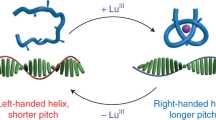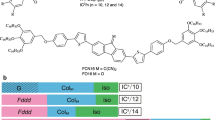Abstract
Molecules that extend and contract under external stimuli are used to build molecular machines with nanomechanical functions. But although common in biological systems, such extension and contraction motions with helical molecules have rarely been accompanied by unidirectional twisting in synthetic systems. Here we show that sodium ions can trigger the reversible anisotropic twisting of an enantiomeric double-stranded helicate, without racemization. An optically active helicate consisting of two tetraphenol strands bridged by two spiroborate groups sandwiches a sodium ion. On removal of the central sodium—through addition of a cryptand [2.2.1] in solution—the double helicate extends. Crystallographic and nuclear magnetic resonance studies reveal that the extended helicate is over twice as long as the initial molecule, and is twisted in the right-handed direction. Circular dichroism analysis suggests that the twisting doesn't affect the helicate's handedness. This anisotropic extension–contraction process is reversibly triggered by the successive addition and removal of sodium ions in solution.
This is a preview of subscription content, access via your institution
Access options
Subscribe to this journal
Receive 12 print issues and online access
$259.00 per year
only $21.58 per issue
Buy this article
- Purchase on Springer Link
- Instant access to full article PDF
Prices may be subject to local taxes which are calculated during checkout




Similar content being viewed by others
References
Urry, D. W. Molecular machines: How motion and other functions of living organisms stem from reversible chemical changes. Angew. Chem. Int. Ed. Engl. 32, 819–841 (1993).
Fyfe, M. C. T. & Stoddart, J. F. Synthetic supramolecular chemistry. Acc. Chem. Res. 30, 393–401 (1997).
Collin, J.-P., Dietrich-Buchecker, C., Gavina, P., Jimenez-Molero, M. C. & Sauvage, J.-P. Shuttles and muscles: Linear molecular machines based on transition metals. Acc. Chem. Res. 34, 477–487 (2001).
Kinbara, K. & Aida, T. Toward intelligent molecular machines: Directed motions of biological and artificial molecules and assemblies. Chem. Rev. 105, 1377–1400 (2005).
Jousselme, B. et al. Crown-annelated oligothiophenes as model compounds for molecular actuation. J. Am. Chem. Soc. 125, 1363–1370 (2003).
Jiménez, M. C., Dietrich-Buchecker, C. & Sauvage, J.-P. Towards synthetic molecular muscles: Contraction and stretching of a linear rotaxane dimer. Angew. Chem. Int. Ed. 39, 3284–3287 (2000).
Liu, Y. et al. Linear artificial molecular muscles. J. Am. Chem. Soc. 127, 9745–9759 (2005).
Fang, L. et al. Acid-base actuation of [c2]daisy chains. J. Am. Chem. Soc. 131, 7126–7134 (2009).
Bell, T. W. & Jousselin, H. Self-assembly of a double-helical complex of sodium. Nature 367, 441–444 (1994).
Jung, O.-S., Kim, Y. J., Lee, Y.-A., Park, J. K. & Chae, H. K. Smart molecular helical springs as tunable receptors. J. Am. Chem. Soc. 122, 9921–9925 (2000).
Yashima, E., Maeda, K. & Sato, O. Switching of a macromolecular helicity for visual distinction of molecular recognition events. J. Am. Chem. Soc. 123, 8159–8160 (2001).
Barboiu, M. & Lehn, J.-M. Dynamic chemical devices: Modulation of contraction/extension molecular motion by coupled-ion binding/ph change-induced structural switching. Proc. Natl Acad. Sci. USA 99, 5201–5206 (2002).
Pengo, P. et al. Quantitative correlation of solvent polarity with the alpha -/310-helix equilibrium: A heptapeptide behaves as a solvent-driven molecular spring. Angew. Chem. Int. Ed. 42, 3388–3392 (2003).
Berni, E. et al. Assessing the mechanical properties of a molecular spring. Chem. Eur. J. 13, 8463–8469 (2007).
Kim, H.-J., Lee, E., Park, H.-S. & Lee, M. Dynamic extension-contraction motion in supramolecular springs. J. Am. Chem. Soc. 129, 10994–10995 (2007).
Percec, V., Rudick, J. G., Peterca, M. & Heiney, P. A. Nanomechanical function from self-organizable dendronized helical polyphenylacetylenes. J. Am. Chem. Soc. 130, 7503–7508 (2008).
Chalmers, R., Guhathakurta, A., Benjamin, H. & Kleckner, N. Ihf modulation of tn10 transposition: Sensory transduction of supercoiling status via a proposed protein/DNA molecular spring. Cell 93, 897–908 (1998).
Schoenauer, R. et al. Myomesin is a molecular spring with adaptable elasticity. J. Mol. Biol. 349, 367–379 (2005).
Nishinaka, T., Doi, Y., Hara, R. & Yashima, E. Elastic behavior of reca-DNA helical filaments. J. Mol. Biol. 370, 837–845 (2007).
Eelkema, R. et al. Molecular machines: Nanomotor rotates microscale objects. Nature 440, 163 (2006).
Goto, H., Furusho, Y. & Yashima, E. Supramolecular control of unwinding and rewinding of a double helix of oligo-resorcinol using cyclodextrin/adamantane system. J. Am. Chem. Soc. 129, 109–112 (2007).
Goto, H., Furusho, Y. & Yashima, E. Double helical oligo-resorcinols specifically recognize oligosaccharides via heteroduplex formation through noncovalent interactions in water. J. Am. Chem. Soc. 129, 9168–9174 (2007).
Goto, H., Katagiri, H., Furusho, Y. & Yashima, E. Oligoresorcinols fold into double helices in water. J. Am. Chem. Soc. 128, 7176–7178 (2006).
Katagiri, H., Miyagawa, T., Furusho, Y. & Yashima, E. Synthesis and optical resolution of a double helicate consisting of ortho-linked hexaphenol strands bridged by spiroborates. Angew. Chem. Int. Ed. 45, 1741–1744 (2006).
Koumura, N., Zijistra, R. W. J., Van Delden, R. A., Harada, N. & Feringa, B. L. Light-driven monodirectional molecule rotor. Nature 401, 152–155 (1999).
Acknowledgements
This work was supported in part by Grant-in-Aids for Scientific Research from the Japan Society for the Promotion of Science (JSPS) and for Scientific Research on Innovative Areas, “Emergence in Chemistry” (21111508) from the MEXT. We acknowledge Y. Kondo and K. Nagamori of JASCO for their help in the measurements of the stopped-flow CD spectra.
Author information
Authors and Affiliations
Contributions
Y.F. and E.Y. designed and directed the project and K.M. performed the experiments. K.M., Y.F. and E.Y. analysed and discussed the results and co-wrote the manuscript.
Corresponding authors
Ethics declarations
Competing interests
The authors declare no competing financial interests.
Supplementary information
Supplementary information
Supplementary information (PDF 4287 kb)
Supplementary information
Crystallographic information for the double helicate DH2BB2−. (CIF 67 kb)
Supplementary information
Crystallographic information for the Na-containing double helicate DH2BNaB−. (CIF 71 kb)
Rights and permissions
About this article
Cite this article
Miwa, K., Furusho, Y. & Yashima, E. Ion-triggered spring-like motion of a double helicate accompanied by anisotropic twisting. Nature Chem 2, 444–449 (2010). https://doi.org/10.1038/nchem.649
Received:
Accepted:
Published:
Issue Date:
DOI: https://doi.org/10.1038/nchem.649
This article is cited by
-
Single crystals of mechanically entwined helical covalent polymers
Nature Chemistry (2021)
-
Water-mediated deracemization of a bisporphyrin helicate assisted by diastereoselective encapsulation of chiral guests
Nature Communications (2019)
-
Cation triggered spring-like helicates based on ketone-substituted bis-catechol ligands
Journal of Inclusion Phenomena and Macrocyclic Chemistry (2019)
-
Higher-generation type III-B rotaxane dendrimers with controlling particle size in three-dimensional molecular switching
Nature Communications (2018)
-
Dynamic control of chirality and self-assembly of double-stranded helicates with light
Nature Chemistry (2017)



